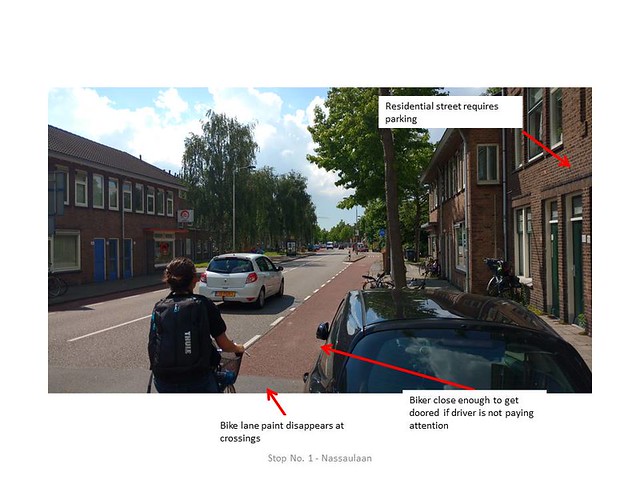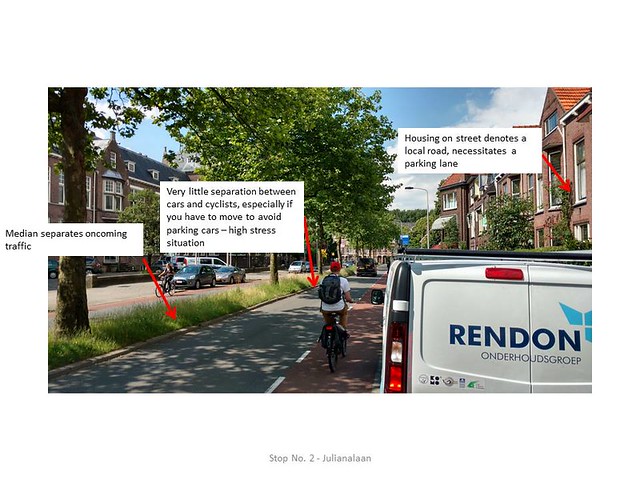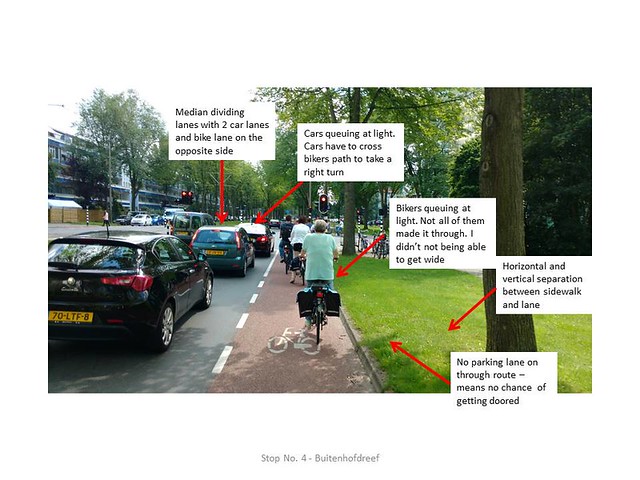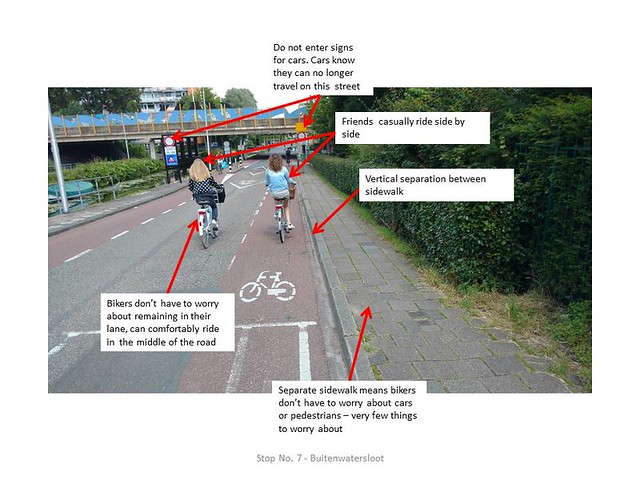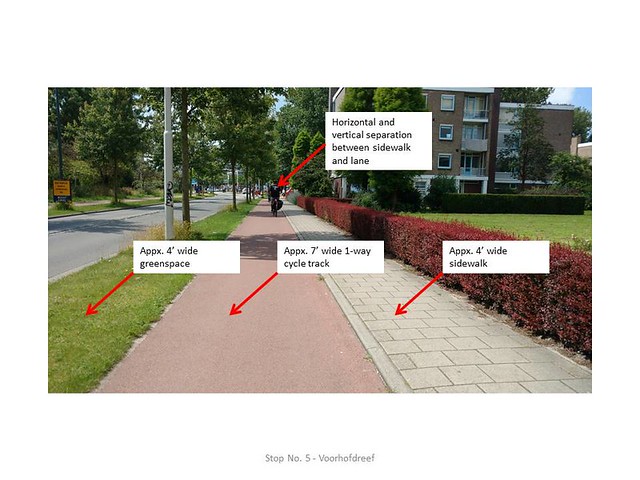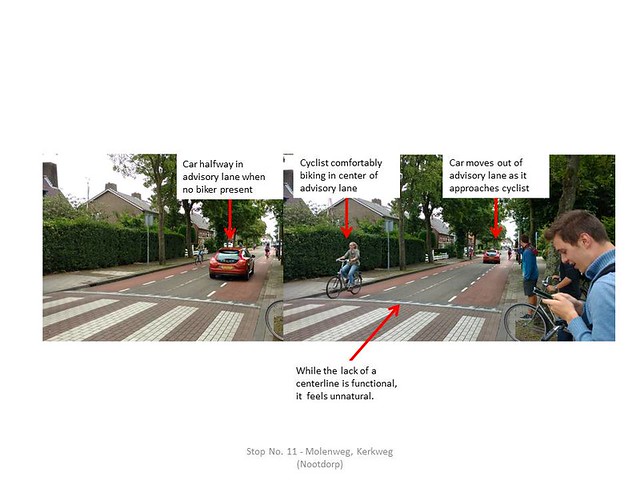Assignment 4: Delft Bicycling Facilities: Holbrook Phelan
The following assignment compiles observations regarding safety, space, and overall cost, taken from visiting eleven different street segments that demonstrate five different types of bike facilities. These bike facilities were mostly found in and around Delft with one of them being found in Nootdorp.
Bike Lanes (Stop Nos. 1, 2, 4)
The bike lanes we visited were the most similar facilities we have seen to those in the United States. In terms of my own comfort, they were my least favorite facility. So far I’ve felt very comfortable biking, but in the bike lanes I felt myself resorting to old habits that I have when I’m biking around Boston. I found myself looking over my left shoulder to see if there were cars behind me, anxious that if a parked car opened their door I would have to leave the bike lane and enter the car lane. While bike lanes are very cost effective, there is a tradeoff with cyclist comfort. Pedestrians and cars remain relatively unaffected by bike lanes. Cars just have to be more aware when parking and yield to cyclists as they are entering and exiting the space.
Stop No. 1 was a bike lane on a 1+1 with parking on either side of the road. It was a local road with some shops, homes, and a school. It seemed like a relatively low volume street that was simply a connector from the main road to the rotary at its other end. For this reason, I think that they went with the bike lane option, especially because it is a short street segment where I think that they can get away with this treatment. The school zone also causes cars to reduce speed so I think that attributed to their decision to put in a bike lane. I noticed that when we entered the school zone they got rid of the bike lane lines altogether, saving money there as well. I felt close to cars and very anxious about cars passing me. The picture below shows how close a cyclist is to parked cars on this street and hence my discomfort (Photo 1).
Photo 1
Stop No. 2 was the most stressful street segment of all the ones that we visited. Julianalaanstraat was also a 1+1 with parking lanes on either side, separated by a median. During my ride, I had a car trying to exit a parking space in front of me and I wasn’t sure what to do. I’m assuming that bikes have the priority in that situation, I’m just used to hesitating as I would at home because I assume that the driver is not going to see me. The driver did use their signal but I still didn’t trust that they were looking out for me. I think that the main thing I’ve noticed is that I have this skepticism towards Dutch drivers meaning that I don’t expect them to do the right thing or be on the lookout for me (because the majority of Boston drivers never do). I’m also skeptical that even if we can learn all these lessons from the Dutch regarding bike infrastructure design and can implement them in the United States that the culture won’t readily accept them. Hopefully this view will be changed by this Dialogue. Throughout the entire ride my comfort level was low but tolerable. In observing other Dutch riders I didn’t see a noticeable difference in their demeanor or riding style. However, I did notice that there weren’t many children riding with parents on this road. Please see additional observations below (Photo 2).
Photo 2
Stop No. 4 was a bike lane on a 2+2 road with no parking on either side. Since this was a throughway, there are no homes or shops and therefore no parking. I really appreciate the Dutch style of categorizing their roads and then designing for each category. I appreciated that there were no parked cars because it eliminated one of my biggest discomforts associated with bike lanes – getting doored. I also like the pocket bike lane that allowed bikes to avoid getting hit by cars taking right hand turns. The most stressful part was queuing at intersections as can be seen in the photo below (Photo 3). I didn’t like queuing so close to cars and that we couldn’t “get wide”. I got stuck in some traffic at lights and had to end up waiting for the next light cycle. While this bothered me, the Dutch did not seem phased by this. Another observation I had was just how smooth the bike path was. Back home I feel like bike paths are forgotten road shoulders that have lots of potholes and obstacles. I appreciated that this bike path was obstacle free. This lost cost options works well in this situation because the through way eliminates parked cars and means that bikers only have to pay attention to the moving cars on their left, which should be yielding to them anyway.
Photo 3
Bike Boulevard (Stop No. 7)
Stop No. 7 was the only bike boulevard that we visited as Stop No. 3 was closed for construction. I liked the bike boulevard a lot. Eliminating the most threatening hazard that cyclists face, the car, eliminated any stress. I found that all of the Dutch cyclists I observed navigated this street segment with ease. Two friends can be seen leisurely enjoying the boulevard, as seen in the picture below (Photo 4). It felt like an American bike path except much wider. This bike boulevard was created by demotion when a new bypass road to Delft was built. I found this concept to be revolutionary because we never do this in America, we just end up with two roads. In Mark Wagenbuur’s lecture he mentioned demotion and said that obviously you would demote the old road because you no longer needed it. I found this very funny because this never would have been obvious to me because I had never seen it done before. I’ve noticed in some of the other lectures from our Dutch professors that many things that seem obvious to the Dutch are just being brought to my attention. In terms of cost, this is a very cheap option compared to other bike facilities. A few bollards to stop vehicular traffic and line paint is much cheaper than constructing cycle tracks with barriers. In terms of space constraints, the canal is one boundary that cannot easily be changed. But since there are no cars, the street does not need to be very wide and this constraint is not an issue.
Photo 4
Cycle Tracks (Stop Nos. 5, 6, 10)
Stop No. 5 was a 2+2 through way with 1-way cycle tracks on either side. 1-way cycle tracks are appropriate in this situation because there aren’t many shops or places to stop along the way that would be easier to navigate with a 2-way cycle track. I felt very at ease on this route. I find that on cycle tracks I forget that the cars are next to me where as in bike lanes I am constantly aware of the cars to my left. This parkway seemed very similar to Stop No. 4 which had a bike lane. I’m wondering why this one wasn’t a bike lane or why that one wasn’t a cycle track as they seemed to be similar scenarios. It could be that this segment could had the width to accommodate cycle tracks and their associated separation. The photo below shows a biker very at ease on the cycle track (Photo 5). I noticed that everyone was very relaxed on this portion. It is amazing how little nuances, such as a ~3″ curb creating a vertical separation, can provide such a high level of comfort. The trade of for this comfort is of course the cost of building cycle tracks on either side.
Photo 5
Stop No. 6 was a very wide street that had a sidewalk, 2-way cycle track, parking lane and driving lane on either side with a tram lane separating the two sides. The 2-way cycle track is appropriate in this situation because this is a shopping street. The 2-way cycle track allows shoppers to go from shop to shop without have to cross the street and do weird loops to get to shops (Photo 6). Most people would treat it like a 2-way cycle track anyway even if it wasn’t. This is a really good example of the Dutch designing for the users of the system and their desire lines. The trade off for this convenience and level of comfort is the cost to build an expansive and wide 2-way cycle track. 2-way cycle tracks are one of the most expensive bike facilities to construct and require the most land. Luckily this segment isn’t in historic Delft and has more space to work with.
Photo 6
Stop No. 10 was a 1-way cycle track leading away from Delft’s historic district. I found it to be a very low stress ride with the exception of crossing. When I had to cross I yielded to the 2-way car traffic and began to cross but then had to yield to bike traffic and found myself in this weird limbo of half on the street and almost but not yet on the cycle track. It was only a few second but I wonder if I should have waited until I could clear both lanes of vehicular traffic and cycle track traffic before I had crossed. One of the most notable pieces of this ride was the raised crosswalk as seen in the Photo 7 below. The raised crosswalk allows bikers to not reduce speed and to be easily seen from drivers approaching in either direction because the car approaches the bikers at a 90 degree angle. With bike lanes, cars taking right turns approach bikers at very acute angles that limit visibility and make for dangerous right hook situations. I really appreciate that the crosswalk was set back from turning traffic so that cyclists are much more visible to cars making turns. This made me feel very comfortable when crossing streets on the cycle track. This 1-way cycle track works in this scenario because this road is more of a through way to Delft with very few shops that would encourage a 2-way cycle track.
Photo 7
Advisory Lane (Stop Nos. 8, 9, 11)
Stops 8 & 9 had advisory lanes in both 1-way traffic and 2-way traffic with parked cars on both sides of the road in both scenarios. I felt okay in the advisory lanes in terms of comfort. Oddly enough I felt more comfortable in the advisory lanes than in the bike lanes. I think this was because cars drove behind you and had to reduce their speed to go aroud you where as cars drove by at a constant speed in the bike lanes. The car volume was relatively low and this area was partially in a school zone where cars are supposed to reduce speed anyway. I liked the advisory lane more so on the 1-way road because the car had plenty of space and did not need to worry about encroaching on the advised lane. I also appreciated some medians that were placed in the middle of the road that forced cars to reduce their speed as well. An example of these medians can be seen in Photo 8 below. These medians show that advisory bike lanes are only advisory and that other supplemental measures can really assist in making them more effective. I think that this treatment works well in this very residential area that have narrow streets. I also appreciated how the painting of the advisory lanes intuitively makes you want to ride in the advisory lane. It is interesting how color in terms of road paint and road signage can have a great effect on the success of bike facilities.
Photo 8
Stop No. 11 had advisory lanes in 2-way traffic with parking on both side of one leg of this segment. The leg with parking was more residential while the stretch without it was more of a throughway to reach Nootdorp, which makes sense. The most stressful part of this street segment was the left hand turn onto Kerk Weg. There were no sharpst symbols and I am not comfortable enough yet with equal priority to navigate that situation. I slowed down to yield but I think that some of the cars let me go when they truly had priority. The advisory lanes themselves were fine to ride in. Cars drove in the advisory lane until they were approaching a cyclist and then went around, as can be seen in Photo 10. I did feel that these streets were higher volume streets than those at Stops 8 & 9. I felt somewhat uncomfortable at points, however the few Dutch I saw bicycling handled the situation with ease. I did not see many children on the routes though, however it was during normal school hours. I’m wondering if cycle tracks are more popular in more urban areas such as the Hague and Delft while more passive techniques such as advisory lanes are more common in suburban areas such as Nootdorp, perhaps due to lower traffic volumes and less municipal funding.
Photo 9
Bike Highway (Stop No. 14)
Stop No. 14 wasn’t completely a stop for my group but we did unknowingly ride through it. I really enjoyed the bike highway. Functionally, it served its purpose, meaning that it did not have many intersections due to over and under passes, and allowed you to go at high speeds. The bike highway was wide enough for us to pass easily, letting you go really fast if you wanted to. I found myself looking at all of my surroundings and not focusing on having to bike or turn or worry about anything. I appreciated the underpass that let us avoid the busy highway above. However, bike highways are expensive compared to bike lanes or doing nothing, but they can cut through the countryside very easily and do not need the space that complete roads require. The Dutch we passed were very content on this road.
Service Road – Not Visited

